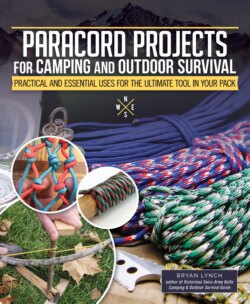Читать книгу Understanding Wood Finishing, 3rd Revised Edition - Bryan Lynch - Страница 35
На сайте Литреса книга снята с продажи.
Sew
ОглавлениеThe last method is a bit more involved but holds very well. This works best with a threading needle or upholstery needle, but most people don’t tend to carry these around. (But if you are carrying paracord, I recommend carrying a few different types of needles in your pack.)
PARA-TIP: Keep It Sharp
A sharp cutting tool will always give clean cuts. If a clean cut is not made, the material will fray a lot and the yarns will be sticking out.
1. Make two clean cuts, one on each end of the cord. Push the outer sheath back so that about 1–2 in. (2.5–5 cm) of the inner strands are exposed. Then, cut those strands off and pull the outer sheath back up so that the last 1 in. (2.5 cm) of the outer sheath feels hollow. Repeat this process for the other cut end of paracord. The other ends of the cords should be melted and turned into a fine point by rolling the melted ends between your fingers.
Once the hollow ends are in place, cut a hole in one side of the outer sheath that is about ½–1 in. (1.3–2.5 cm) from the end. Thread one pointed end of one piece through the hole of the other piece and pull the strand through, leaving a few inches (about 10 centimeters) on one side.
2. Take the melted pointed end of the white cord and thread it through the cut hole and out of the open end of the black cord.
3. Take the melted end of the black cord and thread it through the hole and out of the open end of the white cord. Pull the two lengths taut.
4. Give the two lengths a good tug in opposing directions. Lightly burn this connection and smooth it out.
5. Be careful not to melt too much or the connection will be weakened.
